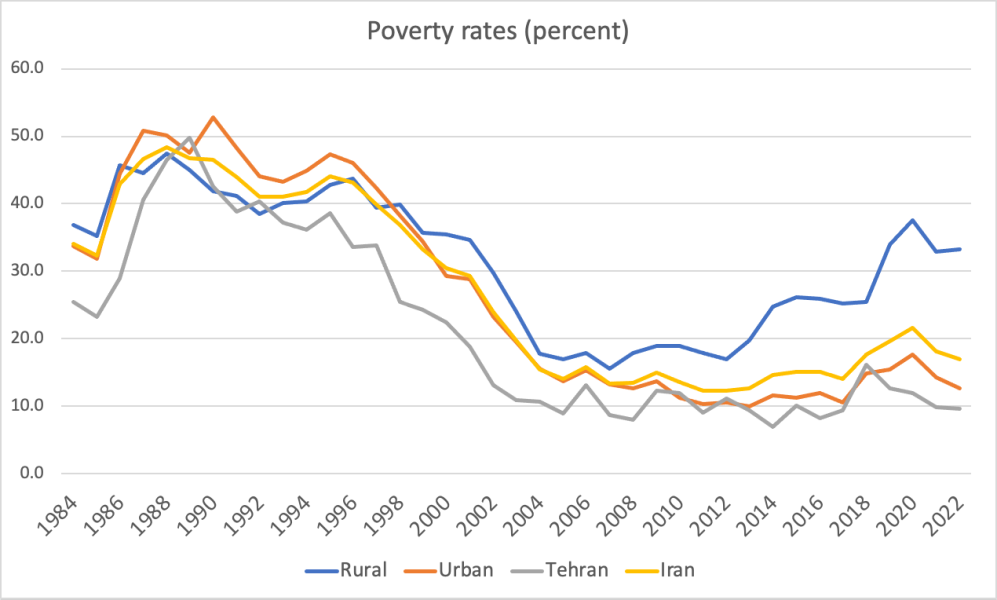Overall Insight
In the Iranian year 1401 (2022/2023), marked by President Ebrahim Raisi’s tenure, significant economic changes occurred. The year witnessed a 52% depreciation of the currency and a record-breaking 300% annual increase in prices due to the removal of food subsidies and the Russian invasion of Ukraine. Despite early fears of hyperinflation, inflation moderated to 45% for the year. Critics had argued that Raisi’s policies were disproportionately affecting the poor and middle class.
Analysis of Income Data
However, an analysis of the Household Expenditures and Incomes Survey (HEIS) data for 1401 reveals a different story. Nominal incomes increased, with rural areas experiencing a 58.1% rise, urban areas 51.8%, and urban areas in Tehran province 46.1%. These figures compare favorably with the national inflation rate, suggesting that incomes kept pace with rising prices, with rural areas even seeing a real income increase.
Economic Impact of Prices
Economically, it is understood that prices are also incomes, as they reflect payments to workers and input owners. Therefore, higher prices can result in increased income for various economic participants. The data indicates that the easing of sanctions and higher oil prices, leading to economic growth, positively impacted incomes across Iran.
Household Consumption and GDP Growth
Examining household consumption, average real per capita expenditures increased during 2021-2022 by 9.0% nationally, with rural and urban areas seeing increases of 9.5% and 12.2%, respectively. While Tehran province lagged behind, these consumption increases aligned with GDP growth.
Poverty Rates and Agricultural Challenges
Looking at poverty, poverty rates improved nationally from 21.6% in 2020 to 17.0% in 2022, with notable improvements in urban areas. However, rural areas experienced a slight increase in poverty, attributed in part to a decade-long drought affecting agricultural value added.
Income Distribution and Inequality
Income distribution also improved, with the Gini index falling from 0.410 in 2020 to 0.397 in 2022.
Impact of Subsidy Reforms and Cash Transfers
Contrary to some political narratives, the data suggests that removing regressive subsidies and providing cash to the poor reduced poverty. Neither the 2010 energy subsidy reform nor the 2022 reform of foreign exchange subsidies harmed the poor, and cash transfers may have lifted some out of poverty.
Historical Context of Poverty Reduction
The historical context of poverty reduction in Iran shows mixed results, with poverty declining under various administrations, often influenced by factors beyond their control. The representation of poverty reduction in political discourse has had a lasting impact on Iran’s political landscape.
Conclusion
In conclusion, an analysis of economic data for the Iranian year 1401 paints a complex picture of economic conditions, income distribution, and poverty rates, challenging certain political narratives and highlighting the nuanced relationship between economic policies and outcomes in Iran.
Professor Djavad Salehi-Isfahani
 This essay is a concise overview of a blog post authored by Professor Djavad Salehi-Isfahani, a distinguished scholar at Virginia Tech. Professor Salehi-Isfahani, currently serving as a Professor of Economics at Virginia Tech in Blacksburg, Virginia, brings his extensive expertise to the forefront in the blog titled “Iranian living standards in times of high inflation,” which was featured on his blog, “Tyranny of Numbers.” Beyond his role at Virginia Tech, Professor Salehi-Isfahani is a Research Fellow at the prestigious Economic Research Forum in Cairo, a testament to his international recognition and contributions to the field of economics. Moreover, as a Research Affiliate at the Middle East Initiative, Harvard Kennedy School, he maintains a strong connection to the renowned institution, further enhancing the credibility and depth of his insights on economic matters.
This essay is a concise overview of a blog post authored by Professor Djavad Salehi-Isfahani, a distinguished scholar at Virginia Tech. Professor Salehi-Isfahani, currently serving as a Professor of Economics at Virginia Tech in Blacksburg, Virginia, brings his extensive expertise to the forefront in the blog titled “Iranian living standards in times of high inflation,” which was featured on his blog, “Tyranny of Numbers.” Beyond his role at Virginia Tech, Professor Salehi-Isfahani is a Research Fellow at the prestigious Economic Research Forum in Cairo, a testament to his international recognition and contributions to the field of economics. Moreover, as a Research Affiliate at the Middle East Initiative, Harvard Kennedy School, he maintains a strong connection to the renowned institution, further enhancing the credibility and depth of his insights on economic matters.
Link to the original blog post:
Iranian living standards in times of high inflation | Tyranny of numbers
Originally published on LinkedIn: This article was originally published on LinkedIn on October 8, 2023. In the article, I discuss ideas of the writer on the Iranian living standards with a glimpse on # Income, Poverty, and Policy Impact. I encourage you to read the original article for more information and insights, and to connect with me on LinkedIn to continue the conversation.
